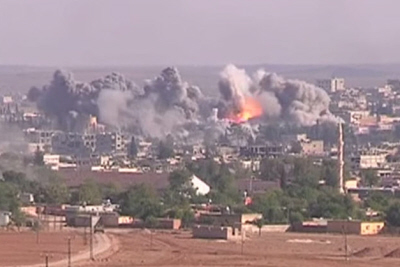
The Mideast Conflict: A Basic Primer
Introduction
“It’s a dirty job, but someone’s gotta do it.” Yes, trying to summarize the Mideast crisis is – if not dirty, at least a difficult job – but someone’s gotta do it. You and I are living out our lives on the sidelines of one of history’s biggest conflicts, and it would be a shame for us to never understand the drama that we live through, even as it happens before our eyes.
Today I will attempt to summarize the basic components of this crisis. The Middle East is a vast territory, covering hundreds of thousands of square miles. The people in this region are diverse. It is difficult to understand this conflict clearly, and the roots of the conflict are hundreds of years old. Still, we read about it in the newspaper, see it on television, and vote for politicians who will directly interfere in it. We may as well understand the conflict itself.
Introducing the Middle East
Those who survey Americans on their knowledge of geography are often appalled. What? You don’t know where Egypt is?! Don’t be one of those people. Take a moment to examine the map below. In particular, identify the following four countries: Iran, Israel, Saudi Arabia, and Turkey. They are all ‘key players’ in the Middle East, and you will hear about them frequently in the news.
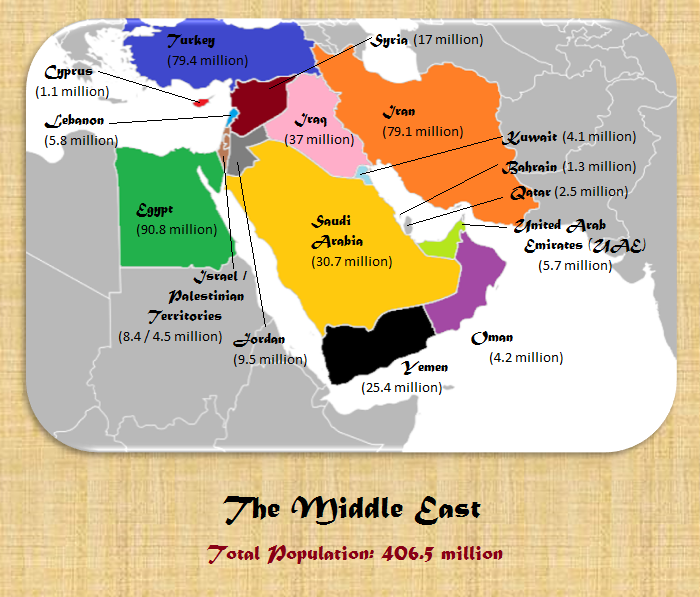
The Major Players
 Iran – This nation is the leader of the Shiite bloc (which we will discuss below). Iran is headed by a Supreme Leader who has a vast amount of power. Presidents essentially serve as figureheads. Iran has a powerful military and a strongly anti-American stance.
Iran – This nation is the leader of the Shiite bloc (which we will discuss below). Iran is headed by a Supreme Leader who has a vast amount of power. Presidents essentially serve as figureheads. Iran has a powerful military and a strongly anti-American stance.
 Israel – A traditional US ally, Israel is a democratic Jewish state. It is the only nation in this region (beside Cyprus) to have a majority non-Muslim population. Ideologically, it is quite secular (and consequently more in line with current American policies). Israel more or less administers the Palestinian Territories. Founded by Great Britain in 1948, many Muslims believe that this state ‘stole’ the land of Palestine from them. The animosity only increased since Israel has soundly defeated several Muslim coalitions.
Israel – A traditional US ally, Israel is a democratic Jewish state. It is the only nation in this region (beside Cyprus) to have a majority non-Muslim population. Ideologically, it is quite secular (and consequently more in line with current American policies). Israel more or less administers the Palestinian Territories. Founded by Great Britain in 1948, many Muslims believe that this state ‘stole’ the land of Palestine from them. The animosity only increased since Israel has soundly defeated several Muslim coalitions.
 Saudi Arabia – This nation, an absolute monarchy, holds an extremely conservative interpretation of Islam. It still has a religious police, and officially, all Saudi citizens are Muslims. Conversion is considered apostasy and is punished by death. Arabia is the land where Islam was born, and it is rich with oil. Despite its enmity with Israel, this nation is a US ally.
Saudi Arabia – This nation, an absolute monarchy, holds an extremely conservative interpretation of Islam. It still has a religious police, and officially, all Saudi citizens are Muslims. Conversion is considered apostasy and is punished by death. Arabia is the land where Islam was born, and it is rich with oil. Despite its enmity with Israel, this nation is a US ally.
 Turkey – Constitutionally secular, this nation is also overwhelmingly Muslim; it is ethnically different from much of the Middle East because its population is Turkic (Central Asian) rather than Mediterranean or Arab. Prior to 1918, Turkey was the seat of the Ottoman Empire, which ruled the Middle East. Turkey has been trying for some time to enter the European Union. With its huge Muslim population, secular constitution, and proximity to Europe, Turkey finds itself somewhere in the middle of Europe and the Arab World.
Turkey – Constitutionally secular, this nation is also overwhelmingly Muslim; it is ethnically different from much of the Middle East because its population is Turkic (Central Asian) rather than Mediterranean or Arab. Prior to 1918, Turkey was the seat of the Ottoman Empire, which ruled the Middle East. Turkey has been trying for some time to enter the European Union. With its huge Muslim population, secular constitution, and proximity to Europe, Turkey finds itself somewhere in the middle of Europe and the Arab World.
Islam: The Unifying Factor
Islam Summarized
Islam springs from the Judeo-Christian tradition; it began on the Arabian Peninsula in the early 7th century. Muslims believe in one ‘Allah’ and accept many of the same prophets that Jews and Christians accept, including Noah and Abraham. They believe that Jesus was also a prophet – indeed, a preeminent prophet – but not the greatest. The most significant prophet for Muslims is Muhammad, who lived in Arabia and is said to have received the Koran, the Muslim holy book.
Muslims believe in one ‘Allah’ and accept many of the same prophets that Jews and Christians accept, including Noah and Abraham. They believe that Jesus was also a prophet – indeed, a preeminent prophet – but not the greatest. The most significant prophet for Muslims is Muhammad, who lived in Arabia and is said to have received the Koran, the Muslim holy book.
While Muslims accept much of the Jewish and Christian scriptures, they believe these writings have been corrupted. Their creed, known as the Shahada, says that “there is no god but Allah, and Muhammad is his prophet.” All Muslims confess this creed. In Islamic theology, salvation is attained by performing good deeds – especially the five ‘pillars of Islam.’ These five pillars are (1) the Shahada, (2) prayer, (3) giving alms, (4) fasting, and (5) the pilgrimage, or Hajj.
Islam is more than a religion; it is also a strong cultural force. Consider the Arabic language. The Koran is not considered inspired unless it is read in Arabic. It is said to lose its force when translated. This means that learning Arabic is a huge priority for many Muslims. Hence, the common language of Arabic is a unifying cultural factor that unites Muslims from the western coast of Africa to the eastern islands of Indonesia.

Mecca during Hajj
Another example is the Hajj. As one of the five pillars, Hajj is the pilgrimage to Mecca in Saudi Arabia, which every devout Muslim seeks to perform once in their life. Again, Muslims from Senegal to Indonesia are united in this experience, travelling back to Saudi Arabia to see the historical birthplace of their religion. Obviously, these two experiences – learning Arabic and travelling to Arabia – are a strong cultural unifier, and serve to fuse the Muslim world together.
Islam Divided
Islam is divided into two major denominations: Sunni and Shia. The split between Sunni and Shia came about over a dispute of leadership; when Muhammad died, some (Shia) wanted a replacement from his family, while others (Sunni) wanted one chosen by consensus.
Sunni – This is the predominant ‘denomination;’ some say that up to 90% of Muslims are Sunni. Sunni Islam is the largest religious denomination in the world. Saudi Arabia is a major supporter behind the Sunni denomination, especially the ultra-conservative Wahhabi version.
Shia / Shiite – While smaller, Shia still has considerable influence. Most Shia followers live in Iran; they are also a majority of Iraq and Bahrain. Besides a different interpretation of Islamic law, Shia Muslims venerate clerics as saints, somewhat similar to the way that Roman Catholics venerate saints. This is rejected by the Sunni version.
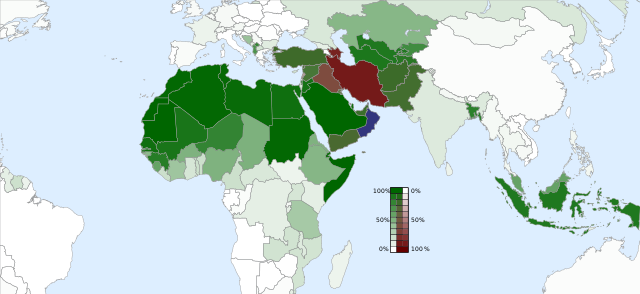
Green indicates Sunni; Red indicates Shia; Blue indicates another denomination, Ibadi. Image credit: Wikipedia
The Islamic Revival
It is noted that Islam has gone through a remarkable revival. In the year 1900, 12% of the world population was Muslim; by the year 2010, 23% was Muslim. This indicates an enormous explosion of Islamic belief. But while the number of Muslims has been increasing, so too has their loyalty to the religion. The return to traditional Islamic faith – not only by numbers, but also by intensity – could be called the Islamic Revival.
Causes
Western Influences & Islamic decline – In the early 1500s, Islam was full of energy, pounding into eastern Europe in the form of the Ottoman empire. Yet after that empire was halted at the gates of Vienna, Islam did not make any more dramatic territorial gains. Slowly the Ottoman empire declined until it was divided up in the 1900s.
Western nations filled the void. The British controlled Israel, Iraq, and Egypt; the French controlled Syria and Lebanon. When they left, they created the ground rules for these nations. And they didn’t completely pull out. They continued to meddle in Middle Eastern affairs, such as when Britain tried to reclaim the Suez Canal in Egypt. America entered the scene as well, promoting secularism in the form of everything from Coca-Cola to Hollywood.
All of these western influences created a powerful backlash; while some Muslims accepted secular thinking, many responded by become more Muslim. The move back toward traditional Islam is twofold. It is partly a backlash against western influence (since Westerners are viewed as having an unfair amount of influence in Muslim nations), and partly a desire for the ‘glorious days of the past’ when Islam was a powerful force in the world, embodied in the Ottoman Empire, and victoriously attacking the European nations.
Israel – Next we come to Israel. While there are multiple viewpoints on this nation, a common Muslim view is that Israel was created by Britain, stole the land of Palestine, and receives a ridiculous amount of unfair advantage because of its alliance with western powers. In fact, Israel unites many Muslims through their shared disgust of the nation. Millions of Palestinians live in refugee camps, and many Muslims look at their plight as the direct fault of Israel.
Results
It comes as no surprise that the huge increase in Islam – measured by both numbers and intensity – would result in significant changes.
Arab Spring & Collapse of Secular Governments – The conservative Islamic revival finally boiled over in the ‘Arab Spring’ of 2012. It was then that many of the secular governments were removed. These governments were not truly secular – they still paid lip-service to Islam – but they did not hold to a strict, conservative view of the religion. Many were headed by dictators who were more concerned about power than piety. Mubarak in Egypt, Qaddafi in Libya, and Assad in Syria, for example, were/are not particularly known for their Muslim piety. During the Arab Spring, many Muslims desired to create truly theocratic nations.
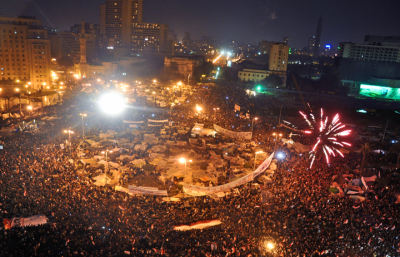
Egypt’s Tahrir Square during the Arab spring, celebrating the removal of the Egyptian president. Photo credit: Wikipedia
Tremendous energy – The Islamic revival also creates an immense swell of energy. The desire for a Palestinian nation, as well as a lack of interference from the western world, echoes deeply with many Muslims. Any government that can tap into this energy has a huge benefit. The question is, who can tap into this power?
The Palestinian people, in particular, are full of energy. Many have sat in refugee camps for years. With very little to live for and the feeling that they are constantly growing weaker, they comprise a volatile group, as this shocking video demonstrates.
The Minor Players
These players are all involved in the middle eastern scene. Each has its own goals. Notice how they try to tap into the immense energy of the Muslim Revival.
Secularists – The secularists do not hold to a strict interpretation of Islam. Some of them may be atheistic or agnostic; others may call themselves Muslim, but only hold to it loosely. Examples of secularists include the Egyptian army leadership (who currently influence the government of Egypt), and (a small portion of) the Syrian rebels. The secularists do not attempt to tap into the power of the Islamic Revival; in fact, they are generally quite opposed to it, because it is too conservative for their likings.

Flag of the Islamic State (ISIS)
Radicals – The radicals are the most widely known players; they are the terrorist organizations like Al-Qaida and ISIS. They are committed to Muslim ‘purity’ and believe that their mission to unite the Muslim world in a caliphate as it was in older times. The west (and secularism in general) is their enemy, and they are quite willing to kill fellow Muslims who belong to a different sect (such as Shia), believing that they are apostate Muslims. (Indeed, they are willing to kill anyone if it will advance their agenda)! The radicals make a direct appeal to the Islamic Revival; they hope that, as Muslims become more conservative, they will enter into the radical camp.
 Kurds – The Kurds, a group of about 30 million people, are a cultural group that was split apart by random borders placed across their land in the mid-twentieth century. Many of them desire to see a nation of ‘Kurdistan’ formed from their homeland. They act as a ‘nation within a nation.’ For example, Iraqi Kurdistan is an autonomous region of northern Iraq with its own government.
Kurds – The Kurds, a group of about 30 million people, are a cultural group that was split apart by random borders placed across their land in the mid-twentieth century. Many of them desire to see a nation of ‘Kurdistan’ formed from their homeland. They act as a ‘nation within a nation.’ For example, Iraqi Kurdistan is an autonomous region of northern Iraq with its own government.
The Major Players
Let’s boil this down to simplicity: there are two Muslim nations that are intent on becoming the ‘regional superpower’ in the Middle East. These two nations want power and influence, and they are involved – either directly or indirectly – in pursuing it, whether through force or diplomacy.
These two nations are Saudi Arabia and Iran. Remember, Saudi Arabia is the proponent of Sunni Islam, and Iran is the proponent of Shia Islam. As you listen to the news, pay attention – you will often find that Iran sides with Shia populations and Saudi Arabia with Sunni populations. For example, the current conflict in Syria pits Sunni rebels (supported by Saudi Arabia) against the Shia government (supported by Iran).
Of course, there are other nations that want this influence, but it is these two nations that are currently closest to attaining it. Take Turkey, for example. As a secular state, Turkey is technically neutral in matters of religion; in reality, the Prime Minister of Turkey is strongly Muslim and trying to move the country toward a more Islamic perspective – at the risk of the constitution. Turkey does this, we may assume, in the hope of once more becoming a leader in the Muslim world, as it was when it led the Ottoman Empire.
Strategy of the Major Players
 Saudi Arabia – Saudi Arabia has a vast amount of oil and uses this to its advantage. In fact, Saudi Arabia’s strategy is a tightrope; on the one hand, it is strictly conservative, but on the other hand, it is the ally of America. This puts it in precarious ground, and creates a strange contradiction – the conservative with the secular. Saudi Arabia banks on a western alliance, but it also tries to remain friends with the anti-American bunch. While it is opposed to Israel, we don’t notice it fighting hard against the nation. On the other hand, America tries hard to keep Saudi Arabia as an ally, but America is not comfortable with the nation. They certainly make for uneasy bed-fellows.
Saudi Arabia – Saudi Arabia has a vast amount of oil and uses this to its advantage. In fact, Saudi Arabia’s strategy is a tightrope; on the one hand, it is strictly conservative, but on the other hand, it is the ally of America. This puts it in precarious ground, and creates a strange contradiction – the conservative with the secular. Saudi Arabia banks on a western alliance, but it also tries to remain friends with the anti-American bunch. While it is opposed to Israel, we don’t notice it fighting hard against the nation. On the other hand, America tries hard to keep Saudi Arabia as an ally, but America is not comfortable with the nation. They certainly make for uneasy bed-fellows.
Saudi Arabia generally sides with America and Sunni peoples. It takes the opposite side of Iran. While it does not want to support outright terrorists (that might anger America), it also wants to promote strict conservative Islam. This means that it supports the Syrian rebels – most of whom are opposed to religious freedom. (Of course, as mentioned earlier, Saudi Arabia’s religious freedom record is a disaster). In Yemen, Saudi Arabia is fighting to keep a Sunni, pro-American government in place.
 Iran – Iran takes the opposite strategy; rather than try to play friendly with America, Iran actively tries to tap into the Islamic Revival and the anti-Western feelings. Notice: Iran is not particularly interested in the cause of Islam, but in the power that it can be obtained through it. Iran actively and vocally hates Israel; but it hesitates to actually fight Israel, knowing that it would be threatened in such a war.
Iran – Iran takes the opposite strategy; rather than try to play friendly with America, Iran actively tries to tap into the Islamic Revival and the anti-Western feelings. Notice: Iran is not particularly interested in the cause of Islam, but in the power that it can be obtained through it. Iran actively and vocally hates Israel; but it hesitates to actually fight Israel, knowing that it would be threatened in such a war.
While Saudi Arabia wants the benefit of American aid, Iran wants to tap into strong Muslim feelings by directly opposing America. It wants Muslims to see it as the proponent of Islam and the answer to American interference.
Iran also tries to court Muslim discontent by its strong policy against Israel. Because many Muslims are outraged against Israel and overwhelmingly favor Palestine, Iran wants to present itself as the answer to Israel and the savior of the Palestinian people. Take, for example, its recent announcement that it will begin paying money to the families of terrorists who die fighting Israel – by announcing this to the world, it casts itself in the role of enemy of Israel and helper of Palestine.
The American Situation
Historical Background
The historical background to America’s situation actually extends far earlier than America. During the Crusades, Roman Catholic armies marched into the Mideast. Fairly or not, Muslims have generally viewed Western influence in the direct light of the Crusades. But unlike the past, when the French were viewed as the ‘leaders’ of the anti-Muslim crusades, Muslims view America as the leader.
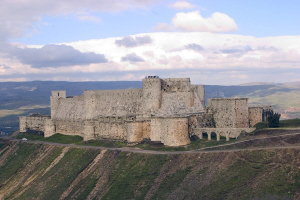 But it’s not true, you cry! America isn’t fighting in Iraq or Afghanistan because it hates Muslims or wants to establish a Christian kingdom! Correct, but not easily recognized to many Muslims. In fact, Muslims see Israel as the exact goal of the Crusades; the modern nation of Israel exactly fits the bill of what the crusaders were fighting for – and as it was in the time of the Crusades, so now the west is determined to support the crusader effort by preserving its ‘toehold’ in Israel.
But it’s not true, you cry! America isn’t fighting in Iraq or Afghanistan because it hates Muslims or wants to establish a Christian kingdom! Correct, but not easily recognized to many Muslims. In fact, Muslims see Israel as the exact goal of the Crusades; the modern nation of Israel exactly fits the bill of what the crusaders were fighting for – and as it was in the time of the Crusades, so now the west is determined to support the crusader effort by preserving its ‘toehold’ in Israel.
The simply reality is that many view America as a new Crusader nation. It doesn’t help that some American soldiers went into Iraq with crosses painted on their vehicles. In fact, it is even rumored that Americans in Iraq were called ‘franj’ – Franks, or French – the very ones involved in the original crusades.
American Goals
 America, of course, doesn’t see itself as a crusader. She has at least three simple, ‘harmless’ goals in the Mideast – friends, business, and oil. She wants friendly nations that do what it tells them to do (though she often turns a blind eye to friends, like Saudi Arabia, with a poor human rights record). She wants a suitable climate for businesses to operate in (since she can gain wealth in that way). And she wants access to oil. Now, with new oil fields used in the North American continent, from Alaska to North Dakota, Middle Eastern oil is less necessary. But it is still useful.
America, of course, doesn’t see itself as a crusader. She has at least three simple, ‘harmless’ goals in the Mideast – friends, business, and oil. She wants friendly nations that do what it tells them to do (though she often turns a blind eye to friends, like Saudi Arabia, with a poor human rights record). She wants a suitable climate for businesses to operate in (since she can gain wealth in that way). And she wants access to oil. Now, with new oil fields used in the North American continent, from Alaska to North Dakota, Middle Eastern oil is less necessary. But it is still useful.
The Current American Position
America is in a tough spot. Many Muslims are opposed to us. We are viewed as the descendants of the crusaders. We are viewed as interfering constantly in Middle Eastern affairs. Take as an example the 1953 coup in Iran, when America – working through the CIA – removed the prime minister. The American-sanctioned government that replaced him was marked by atrocity. Whatever the argument in favor of such CIA-action, deeds like these never make for great press.
From Shia Muslims, the hostility is even worse – America is directly siding with Sunni Saudi Arabia and demonstrates hostility to Shia Iran. In other words, America sides with their worst enemy and spurns their best friend.
The American Debacle – there are lots of misunderstandings in America. We don’t realize how deep the issues are. We are quick to try to ‘make friends,’ but this generally results in bad things. We think that we are the big player in the game, while the other major players (Iran and Saudi Arabia) view us merely as a pawn.
Take, for example, America’s position during the Arab Spring. Mubarak, the Egyptian president, may have been a dictator, but he was also an American ally. When protests erupted, America was quick to support his opposition, and he was removed from office. America wanted friends – and, assuming that Mubarak would be removed, we hoped to show sympathy to the demonstrators. It turns out that many of them were anti-American, even members of the theocratic Muslim Brotherhood.
Conclusion
This guide is only a basic primer. The Mideast conflict is complicated, but sometimes we need to begin with the basics in order to understand the complexities. While this guide does not cover everything, it provides an overview – a ‘40,000 foot picture’ of what is going on in the Middle East.
Important Note: The goal of this primer is to provide a neutral summary of the Mideast crisis from an American perspective, without slanting the facts for or against any particular political viewpoint (democratic or republican). Further, note that while America’s strategies and interventions in the Middle East are not always sensible, this is in no way an attack on the American military, which I highly respect.
Special Offer: Share this Primer on social media to receive a FREE copy of ‘Essential Democracy.’ Click here for more details.

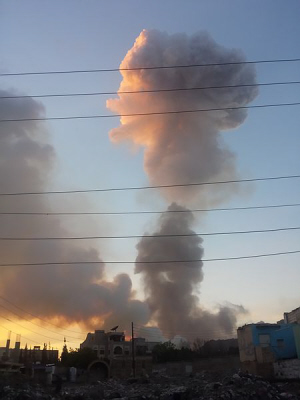



So glad to see you mention the 1953 coup of a free and elected government in Iran which led to deep distrust of the west. Would not we feel the same? We did feel the same and had a revolution of our own. We’ve got to realize how our actions effect others. Needless complications arise when cultural and historical dynamics are not studied and taken into consideration.
That was very, very, very helpful! Thank you.
Under The Black Flag: At The Frontier Of The New Jihad by Saudi historian Sami Moubayed provides an excellent history of Salafist Islamism that has led to the current formation of groups such as ISIS and is an excellent and easy to understand book that furthers comprehension of this subject.
Thanks for the info, Daniel. It’s good to have a basic understanding of the M.E. conflict.